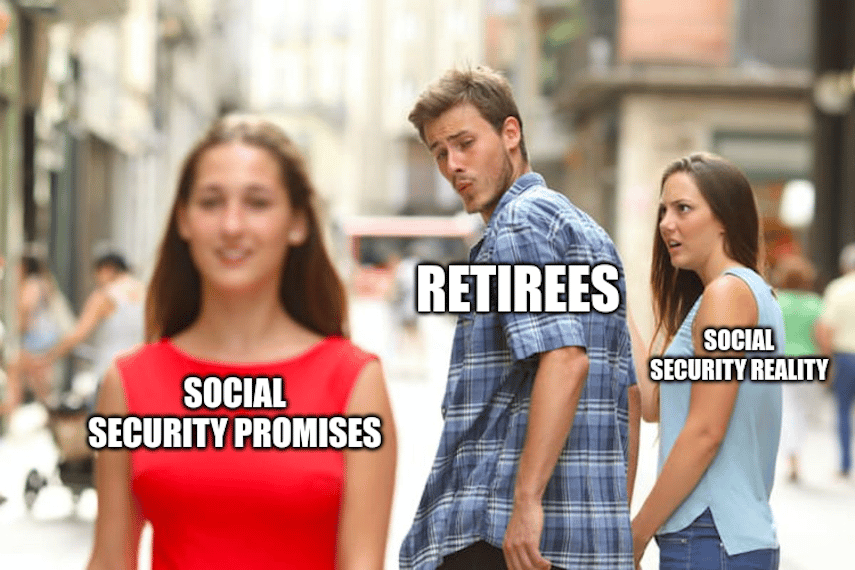
For decades, American retirees have come to depend on Social Security for at least a part of their retirement income. While many retirees have made their own retirement plans and only rely on Social Security for supplemental income, many have planned for Social Security to make up the bulk of their retirement income.
That was never the intent of the Social Security System, as it was intended merely to provide a stopgap so that those who entered retirement wouldn’t be completely destitute if something were to happen to them. But because the first Social Security recipients received so much more money than they paid into the system, many people thought that they could rely entirely or mostly on Social Security for their retirement income. Anyone who still thinks that way is about to get a harsh wake-up call.
The current state of the Social Security System is nothing short of abysmal. While the system currently has significant amounts of assets, its primary trust fund is expected to run out of money by 2035 at the latest. But that estimate may be excessively rosy, resting on assumptions about future economic performance that may be far too optimistic.
One thing is for certain, though. Within less than two decades Social Security is going to face a major crisis. If the federal government fails to find a fix to the problem, those who expected to rely on Social Security for their retirement income will find themselves with far less income in retirement than they had hoped for.
Social Security’s Funding Shortfall
Many people may not realize that the Social Security System already spends more on benefits than it takes in through Social Security payroll taxes. According to the 2019 Social Security trustees’ report, the system is expected to take in $885 billion in Social Security taxes and $35 billion in taxes on Social Security income, for a total of $920 billion in Social Security revenue. But the system is expected to pay out $994 billion in Social Security benefits. That revenue gap is only filled by an expected $83 billion in interest income from the Treasury securities held by the trust fund. Overall, the system is expected to add only $3 billion this year to the trust fund’s assets.
Come 2020, the total amount of Social Security benefits paid out will exceed the combination of Social Security taxes and interest income. That will require drawing down the Treasury securities currently held by the trust fund. And at the current expected drawdown rates, the trust fund is expected to be depleted by 2035. At that point, Social Security receipts will only be enough to pay for about 80 percent of Social Security benefits.
Which Way Will Interest Rates Go?
One of the underlying assumptions behind Social Security’s continued funding is that of interest rates. It was expected that interest rates would continue to rise, keeping the trust fund funded for a longer amount of time. Last year the fund earned an average of 2.9% on its Treasury security holdings. But with the Federal Reserve now cutting interest rates, the securities held by the trust fund will earn less, leading to a faster depletion of the fund’s assets.
The fund holds a variety of Treasury securities with various maturities. As of December 2018, the fund’s longest-dated securities were scheduled to mature in 2033. Much of the fund’s holdings are in shorter-term Treasuries, whose interest rates continue to decline. For instance, while the trust funds new purchases averaged an interest rate of 3.000% in December 2018, they only averaged 2.125% in August 2019. And as short-term securities mature and are rolled over, those new securities will earn less interest than the old ones, leading to a decline in interest income. The further interest rates continue sinking, the worse the trust fund’s financial situation will get.
Special Issue vs. Publicly-Traded Securities
Then there’s the uncomfortable fact that the trust fund’s securities are made up of special issue Treasury securities, i.e. non-marketable Treasury securities. These securities are not available to be bought or sold by the public, but can only be issued to governmental entities such as the Social Security trust funds.
In order to raise the money to pay for Social Security benefits starting in 2020, those securities will have to be sold, then the money received can be disbursed to Social Security beneficiaries. But since the government is the only entity that can buy those securities, this leads to some interesting accounting problems.
The trust fund currently holds $2.9 trillion in Treasury securities. That means that the government will have to purchase and liquidate about $200 billion per year on average of its own debt in order to provide the funds to pay Social Security recipients. But where will the government, which will already be running trillion-dollar deficits, get the money to do that? Why, it will have to issue new debt of course.
Thus we’re looking at hundreds of billions of dollars in new debt being issued every year just to pay for Social Security benefits. Over the next 16 years that’s another $2.9 trillion or more that will end up being added to the debt held by the public to fund the liquidation of Social Security’s trust fund. And that’s assuming that the government can find buyers for that debt. In a worst-case scenario, the government may just decide to reduce benefits rather than continue drawing down the trust fund and issuing new debt.
No matter which way you slice it, Social Security is in dire financial shape, and those who expect to be able to rely on it for retirement income will be sorely disappointed. It’s incumbent upon those looking to retire comfortably to take more responsibility for their own retirement savings. Between the demise of pension plans, the impending bankruptcy of Social Security, and the near certainty of a coming recession, those looking to retire in the next few years will face a bleak economic future and will have to make some hard decisions.
Whether it’s investing in gold, boosting contributions to a workplace 401(k), or some other method, investors need to take the right steps right now to ensure a sound financial future. Relying on promises made by others won’t keep you safe and secure in retirement. Only your own hard work, diligent saving, and shrewd investment will enable you to live the life that you want to.






